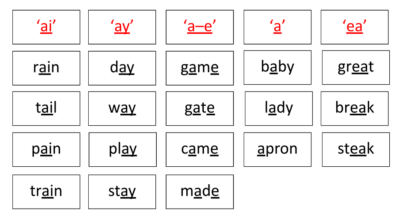In our ‘how to…’ series we are going to delve into all things phonics instruction and give you our expert advice on developing confident readers.
***
One of the difficult aspects of the English Alphabetic Code is that sounds (phonemes) can be spelled in different ways. For example, the sound /ae/ can be spelled ‘ai’ (rain), ‘ay’ (day), ‘a–e’ (came), ‘ea’ (great), and ‘a’ (baby), and these are only the common spellings! As students learn more and more of the code, we want them to build a mental framework that incorporates this concept of multiple spellings. We want our students to understand that sounds can be represented in different ways and to recognize these spelling patterns when they read. Later, they will need to learn which spelling fits in which word.
How can we teach this?
Word sorting
The best way to demonstrate how a sound can be spelled in different ways is through sorting activities. After teaching the students about the graphemes ai and ay for example (ideally through word building), the students should be given words to sort according to spelling. This activity enables the students to compare and contrast words. It will often reveal typical spelling patterns, e.g. that the spelling ‘ay’ comes at the end of a base word while ‘ai’ will usually appear in the middle of the word.

How many alternatives?
The teacher must decide how many alternatives to include when the students carry out this sorting activity. This will depend on the program being followed. It is important not to present these spellings in an isolated way as the students will not make the connection between them. If this activity is part of an intervention program, it is helpful to introduce the different spellings in a gradual way. Always include previous learning so that the concept of “one sound—different spellings” is built on what the students already know.

Word wall in the classroom
A great way to reinforce the different spellings for a sound is to display them in the classroom. This display will remind students of the different ways to spell a sound. New words can be added to the display as they are encountered. This display will then become a useful spelling tool. For example, if a student spells the word “came” as “cam”, the teacher can direct them to the display and say, “Use the a–e spelling in this word.”
The language we use
We can reinforce the concept that a sound can be spelled in different ways by the language we use. When a student encounters an additional way to spell the sound, we say, “Yes, this is another way to spell the sound /ae/.” This dispels the notion that there is only one way to spell the sound /ae/ and develops a flexible approach to a complex code. Students learn that when they spell a sound there are a number of options, and they will need to choose the correct option when they spell a word.


